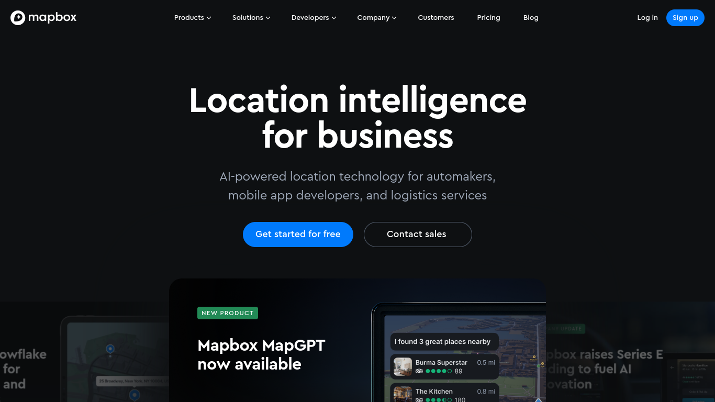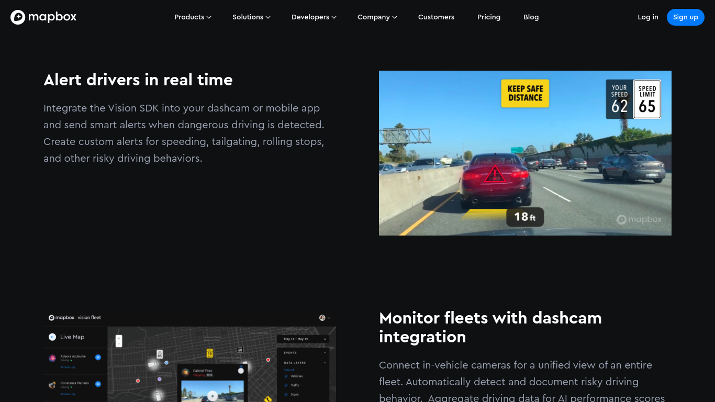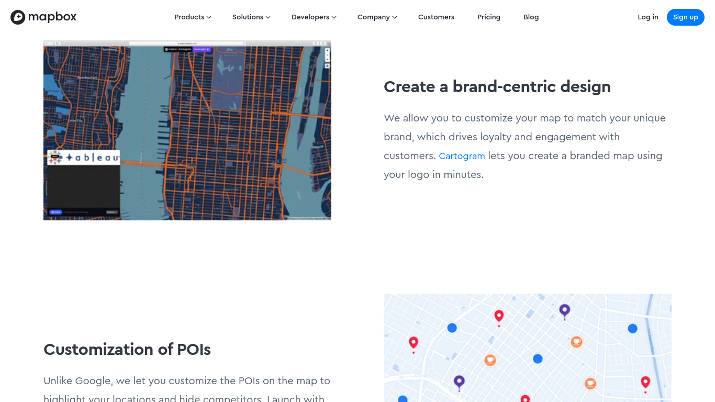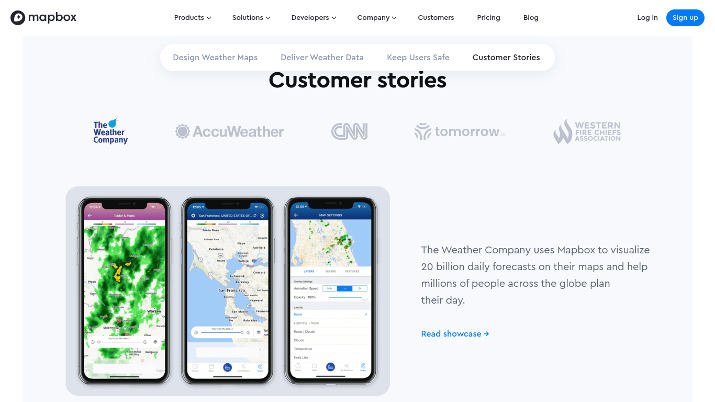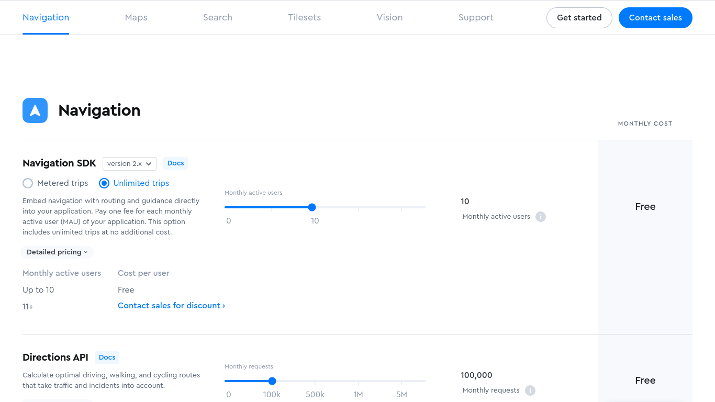Mapbox is a custom mapping software used by companies such as Snapchat, Lonely Planet, and Instacart.
It allows businesses and app developers to provide interactive maps for getting navigational directions, weather data, and more.
In this Mapbox review, I will discuss the main features of Mapbox. I will also talk a bit about who it is for and whether you can benefit from Mapbox.
Let’s get into it.
Verdict
Our Rating: ⭐⭐⭐⭐⭐
Mapbox is one of the best platforms for businesses looking for embedded maps. It allows you to create mobile and web apps that provide navigational directions, weather data, and other services.
It’s also great for logistics, as companies can use it to organize their fleets and benefit from route optimization and vehicle tracking.
Pros
- Every service has a free tier.
- It offers APIs and services for a variety of use cases.
- Mapbox has extensive documentation and a large community.
Cons
- It’s designed for businesses and developers rather than individuals.
- Support is not available for free.
- The platform can be a bit confusing, especially with so many options to choose from.
Mapbox Overview
Mapbox is a software that allows you to embed maps in your apps and websites. For example, if you want to create an app that allows people to get directions, you can do that with Mapbox.
Two famous companies that use Mapbox and its APIs are Instacart, a grocery delivery service, and Snapchat. Snapchat is a popular social media app which also has a feature called Snap Map, where you can see where your friends are in real time on a map.
Mapbox Products and Services
Mapbox has a lot of products and features, and I can’t go over all of them. I will, however, give you an overview of the most important ones.
Navigation
You can embed a map and allow your website visitors or app users to get navigational directions. In other words, you can create an app like Google Maps.
Mapbox handles over 400 billion live location updates every day!
It’s not just for apps and websites, though. Automotive manufacturers can use it to embed a navigational system in the built-in car dashboard, which can work even offline.
This navigational system will be optimized for electric vehicles, when applicable. Electric vehicle owners can benefit from enhanced route planning for EVs (Electric Vehicles), information about the nearest charging stations, and even information about predicted battery levels on arrival, depending on the route taken.
To help users find the best charging stations, there are filters for options such as fast charging, plug-and-charge stations, and charging networks such as ChargePoint and Blink.
Even location context such as elevation, which can affect battery levels, is taken into account when planning routes for EVs. Furthermore, electric vehicle owners can pay for charging services directly from within the app.
In online mode, Mapbox provides real-time traffic updates, ETAs, and optimized route planning based on live traffic conditions.
Logistics
Mapbox also works with fleet operators and delivery services. Using Mapbox’s APIs, you can identify where your customers are located and create optimized routes to serve them better.
You will get important data to help you understand where to strategically locate distribution centers and dark stores (hidden stores that only delivery drivers can access, not customers). It will also help you get products delivered on time by helping you find the right driver for an assignment.
It also helps you plan batch deliveries and routes, especially when there are associated conditions (such as the need for a refrigerated truck).
The navigational app will provide drivers with real-time route planning and optimization based on traffic data to ensure that deliveries get to their destinations on time.
Drivers can even download these maps and routes to be used offline.
Not only will Mapbox improve delivery times, but it will also help you save on fuel by reducing time spent on the road.
Meanwhile, managers can monitor where all drivers and vehicles in their fleets are at all times with live location tracking.
Moreover, you can integrate Mapbox into dashcams and, with the power of AI, detect dangerous driving actions such as tailgating or speeding taken by your drivers, issuing alerts when such behavior happens.
You can get detailed reports for such behavior, with captured images and videos from the dashcams to support these accusations.
With augmented reality, drivers can see data overlays together with navigation. From tips to parking to information about meter prices, drivers can benefit in numerous ways.
MapGPT
MapGPT is a new feature from Mapbox that integrates artificial intelligence with existing navigational features. It allows users to hold conversations with AI and get assistance in real time, whether they need help finding a restaurant or getting weather updates.
With advanced natural language processing, MapGPT can understand open-ended questions and interpret meaning, even from incomplete sentences and statements. It’s available in several languages.
MapGPT also integrates with vehicles, so drivers can control things like temperature by issuing voice commands. Hands-free control is more convenient and helps keep drivers safe.
Furthermore, MapGPT can be used to book reservations and set calendar reminders.
MapGPT doesn’t only support voice chat, though. There is a text-based chat option, and while it’s not meant to be used while driving, users can transition from voice to text chat once they arrive at their destinations.
Store Locators
You can also use Mapbox to create a store locator. If you own a chain brand with various branches, the store locator map will be useful in helping your customers find the closest branch.
Unlike Google, Mapbox allows you to customize which points of interest appear on the map.
Points of interest can help customers find which branch is most convenient for them to visit, but you probably don’t want competitors to show up on the map, and Mapbox allows you to hide them.
Travel Companies
One of the well-known companies that uses Mapbox is Lonely Planet, a company that provides travel guides.
You can create maps that people can use to discover where to go and find guides on destinations they are interested in.
Mapbox can also be used to plan road trips and book hotels all around the world, as it integrates with Hotel.com, a popular booking platform for hotels and serviced apartments.
The map can even be downloaded and used offline so visitors can explore their destinations upon arrival without using data.
Weather
Another use case for Mapbox is creating weather applications. Mapbox supports weather maps with satellite, radar, temperature, and other data.
Whether on desktop or mobile, your users will be able to see updated weather information and forecasts with weather maps. You can also upload your own weather data.
Within your weather or map app, you can provide users with updated alerts for their location, keeping them safe from blizzards, hurricanes, and other inclement weather conditions.
In fact, Mapbox is used by two of the most famous weather apps, including The Weather Company and the famous AccuWeather itself.
Address Search, Verification, and Auto-fill
Mapbox also offers a service in which you can let users search for addresses. They can enter an address and Mapbox will provide address suggestions to automatically fill out the rest of the address.
This is useful for ecommerce, for example, as it speeds up the checkout process.
That way, you don’t have to deal with incorrectly entered street names, zip codes, and other errors.
For database geocoding and address verification, Mapbox is highly efficient as well, using data from over 2,500 sources to ensure you don’t have incorrect address data in your database.
Pricing
Mapbox offers flexible pay-as-you-go pricing plans, with discounts available for volume pricing. Pricing depends on which service you are using, though.
Free plans are available for limited usage for every service and API.
For navigational apps, for example, it’s free for 100 monthly users and 1,000 active trips OR unlimited trips for 10 users. From there on, pricing goes up per user and per trip.
The more volume you have, the cheaper it becomes per user and per trip.
Similarly, for the Optimization API (which helps optimize delivery routes for delivery companies), pricing is free for up to 100,000 monthly API requests.
For Mapbox store locators, it’s free for 50,000 map loads a month, with pricing starting at $5 for each additional 1,000 map loads. In contrast, Google only offers 28,000 free loads per month.
Since pricing depends on the specific APIs you will be using, I suggest you check the pricing page for updated pricing information for your needs.
Do note that support costs extra. Individual support for developers costs $50/month, while support for businesses costs $6,000/year.
See here for updated pricing for support. If you would rather not pay for support, you can use the free community support resources.
Conclusion
Mapbox is a great solution for businesses looking to provide maps, navigational data, weather data, and similar features to their customers. It’s a solid tool if you want to create an app, even for yourself.
However, if you’re an individual looking for satellite data, navigational directions, or weather data for personal purposes, you’d be better served with apps like Google Earth, AccuWeather, and Google Maps.
Tom loves to write on technology, e-commerce & internet marketing. I started my first e-commerce company in college, designing and selling t-shirts for my campus bar crawl using print-on-demand. Having successfully established multiple 6 & 7-figure e-commerce businesses (in women’s fashion and hiking gear), I think I can share a tip or 2 to help you succeed.
